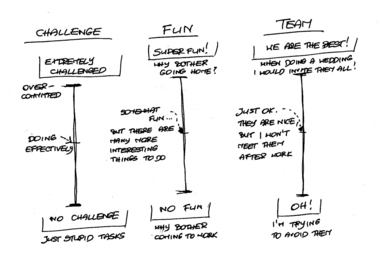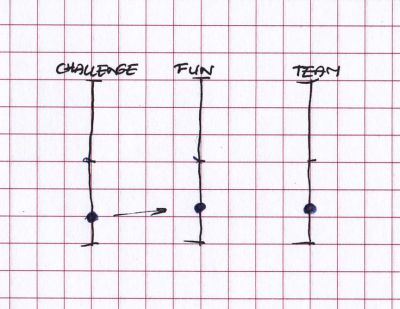We need to establish an atmosphere that will give us feelings and facts that we can discuss, but can also open the discussion and stimulate more questions and ideas, rather than closing them down to just discussing a few pre-prepared bullet points.
Challenge, Fun, Team
There is a very simple technique that I found very successful in serving that purpose. There are three simple questions to ask:
What is your challenge level? What is your fun level? How do you rate your team?
All you need is a sheet of paper—draw three bars on it, explain what they mean, and ask your employee to put three dots on the bars.
The order is really important: challenge, fun, team. Challenge opens the discussion with the right question: “Am I using my skills effectively and do I feel I am developing?” Fun connects strongly with both challenge level and the team perception, that’s why it’s in the middle. Team is a very important factor, too; no action is meaningless in a community.
Examples
There are few typical examples that I found through that exercise:
Effective Conversations
What I like about this exercise is that it gives you a lot of information, and opens up a really great and honest discussion at the same time: “You said you were not challenged enough. What would be a positive challenge for you?” “Your task is critical to us and you are doing well at it, but it seems you are not enjoying it at all. How could we change that?” “You said you were challenged, but it seems that you find no fun in your work. Why?” “It seems that as a person you are challenged appropriately and have real fun, but you rate your team with a very low score. Why?” By asking such questions, people will not only tell you what the problem is, but in most cases they will give you the solution right away. People do not want to be a part of the problem: they want to be a part of the solution. Career conversations are a hot topic right now. As coaching becomes more and more popular, many managers read books related to career conversations like “Help Them Grow or Watch Them Go” or consider using DixIt cards to talk about emotions. They may, however, miss this “standard tool” method that they could use for longer periods of time. This tool worked well in my case and I hope it will also be very successful for you.



